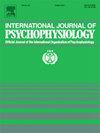Cardiac vagal activity dynamics during anxiety induction and the effects of short-term biofeedback training
IF 2.6
3区 心理学
Q3 NEUROSCIENCES
引用次数: 0
Abstract
The Neurovisceral Integration Model and the Vagal Tank Theory propose that cardiac vagal activity (CVA) changes dynamically in response to self-regulatory demands, yet empirical support remains limited. In Study 1, state anxiety was induced using the Velten mood induction procedure, followed by a 2-min emotional incubation period. CVA—indexed by vagally mediated heart rate variability (vmHRV), specifically high-frequency (HF) component and root mean square of successive differences (RMSSD)—was quantified from electrocardiogram (ECG) recordings during resting, anxiety induction, and recovery phases. Based on findings from Study 1, Study 2 implemented a 10-day HRV biofeedback intervention in healthy college students to evaluate its effects on tonic and phasic CVA. The protocol involves slow-paced breathing (SPB) to enhance cardiorespiratory coupling and modulate vmHRV, with real-time feedback generated from respiratory sinus arrhythmia (RSA)-related heart rate fluctuations. Results showed that CVA during anxiety was significantly higher than during both resting and recovery phases. Additionally, resting CVA was positively correlated with phasic CVA, including both reactivity and recovery. Following biofeedback training, phasic CVA—comprising reactivity and recovery—significantly increased. These findings indicate that CVA increases during emotional regulation, and higher resting CVA facilitates more adaptive vagal responses. Moreover, short-term biofeedback training appears to enhance regulatory capacity under conditions of state anxiety by modulating CVA. Together, this study offers empirical support for both the Neurovisceral Integration Model and the Vagal Tank Theory.
焦虑诱导时心脏迷走神经活动动态及短期生物反馈训练的效果
神经内脏整合模型和迷走神经罐理论提出心脏迷走神经活动(CVA)在自我调节需求下动态变化,但经验支持仍然有限。在研究1中,使用Velten情绪诱导程序诱导状态焦虑,然后进行2分钟的情绪潜伏期。cva是由迷走神经介导的心率变异性(vmHRV),特别是高频(HF)分量和连续差的均方根(RMSSD)指标指标,通过静息、焦虑诱导和恢复阶段的心电图(ECG)记录进行量化。在研究1的基础上,研究2在健康大学生中实施了为期10天的HRV生物反馈干预,以评估其对强力性和阶段性CVA的影响。该方案包括慢节奏呼吸(SPB),以增强心肺耦合和调节vmHRV,并从呼吸窦性心律失常(RSA)相关的心率波动产生实时反馈。结果显示,焦虑期CVA显著高于休息和恢复期。此外,静止CVA与相性CVA呈正相关,包括反应性和恢复。生物反馈训练后,阶段性cva(包括反应性和恢复)显著增加。这些发现表明,CVA在情绪调节过程中增加,而静息CVA的增加促进了更多的适应性迷走神经反应。此外,短期生物反馈训练似乎通过调节CVA来增强状态焦虑条件下的调节能力。总之,本研究为神经内脏整合模型和迷走神经罐理论提供了实证支持。
本文章由计算机程序翻译,如有差异,请以英文原文为准。
求助全文
约1分钟内获得全文
求助全文
来源期刊
CiteScore
5.40
自引率
10.00%
发文量
177
审稿时长
3-8 weeks
期刊介绍:
The International Journal of Psychophysiology is the official journal of the International Organization of Psychophysiology, and provides a respected forum for the publication of high quality original contributions on all aspects of psychophysiology. The journal is interdisciplinary and aims to integrate the neurosciences and behavioral sciences. Empirical, theoretical, and review articles are encouraged in the following areas:
• Cerebral psychophysiology: including functional brain mapping and neuroimaging with Event-Related Potentials (ERPs), Positron Emission Tomography (PET), Functional Magnetic Resonance Imaging (fMRI) and Electroencephalographic studies.
• Autonomic functions: including bilateral electrodermal activity, pupillometry and blood volume changes.
• Cardiovascular Psychophysiology:including studies of blood pressure, cardiac functioning and respiration.
• Somatic psychophysiology: including muscle activity, eye movements and eye blinks.

 求助内容:
求助内容: 应助结果提醒方式:
应助结果提醒方式:


